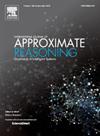Attribute reduction based on weighted neighborhood constrained fuzzy rough sets induced by grouping functions
IF 3.2
3区 计算机科学
Q2 COMPUTER SCIENCE, ARTIFICIAL INTELLIGENCE
引用次数: 0
Abstract
Attribute reduction can extract the most critical attributes from multi-dimensional datasets, this reduces data dimensionality, simplifies data processing and analysis, and the fuzzy rough set (FRS) model-based attribute reduction method is one of the most commonly used attribute reduction methods. In this paper, we construct a new FRS model named G-WNC-FRS for attribute reduction by introducing a new inter-sample distance and two aggregation functions. Specifically, we first introduce the weighted neighborhood constrained distance between samples to make the difference in attributes between different class samples obvious. Then we introduce two not necessarily associative aggregation functions, overlap and grouping functions, to replace the commonly used triangular norms and triangular conorms in FRS model. Finally, we design G-WNC-FRS-based attribute reduction algorithm to select important attributes for classification tasks. Numerical experiments on 11 datasets demonstrate that the attribute reduction algorithm based on G-WNC-FRS has a strong ability to eliminate redundant attributes. Additionally, noise experiments and sensitivity experiments on 4 datasets show that the algorithm has high noise immunity and is able to adapt to different types of datasets.
基于分组函数诱导加权邻域约束模糊粗糙集的属性约简
属性约简可以从多维数据集中提取出最关键的属性,从而降低了数据维数,简化了数据处理和分析,基于模糊粗糙集(FRS)模型的属性约简方法是最常用的属性约简方法之一。本文通过引入一个新的样本间距离和两个聚集函数,构造了一个新的属性约简FRS模型G-WNC-FRS。具体来说,我们首先引入加权邻域约束样本之间的距离,使不同类别样本之间的属性差异变得明显。在此基础上,我们引入了重叠和分组两种不一定相互关联的聚合函数来代替FRS模型中常用的三角范数和三角保形。最后,设计了基于g - wnc - frs的属性约简算法,选择重要属性进行分类任务。在11个数据集上的数值实验表明,基于G-WNC-FRS的属性约简算法具有较强的剔除冗余属性的能力。另外,在4个数据集上进行的噪声实验和灵敏度实验表明,该算法具有较高的抗噪声能力,能够适应不同类型的数据集。
本文章由计算机程序翻译,如有差异,请以英文原文为准。
求助全文
约1分钟内获得全文
求助全文
来源期刊

International Journal of Approximate Reasoning
工程技术-计算机:人工智能
CiteScore
6.90
自引率
12.80%
发文量
170
审稿时长
67 days
期刊介绍:
The International Journal of Approximate Reasoning is intended to serve as a forum for the treatment of imprecision and uncertainty in Artificial and Computational Intelligence, covering both the foundations of uncertainty theories, and the design of intelligent systems for scientific and engineering applications. It publishes high-quality research papers describing theoretical developments or innovative applications, as well as review articles on topics of general interest.
Relevant topics include, but are not limited to, probabilistic reasoning and Bayesian networks, imprecise probabilities, random sets, belief functions (Dempster-Shafer theory), possibility theory, fuzzy sets, rough sets, decision theory, non-additive measures and integrals, qualitative reasoning about uncertainty, comparative probability orderings, game-theoretic probability, default reasoning, nonstandard logics, argumentation systems, inconsistency tolerant reasoning, elicitation techniques, philosophical foundations and psychological models of uncertain reasoning.
Domains of application for uncertain reasoning systems include risk analysis and assessment, information retrieval and database design, information fusion, machine learning, data and web mining, computer vision, image and signal processing, intelligent data analysis, statistics, multi-agent systems, etc.
 求助内容:
求助内容: 应助结果提醒方式:
应助结果提醒方式:


